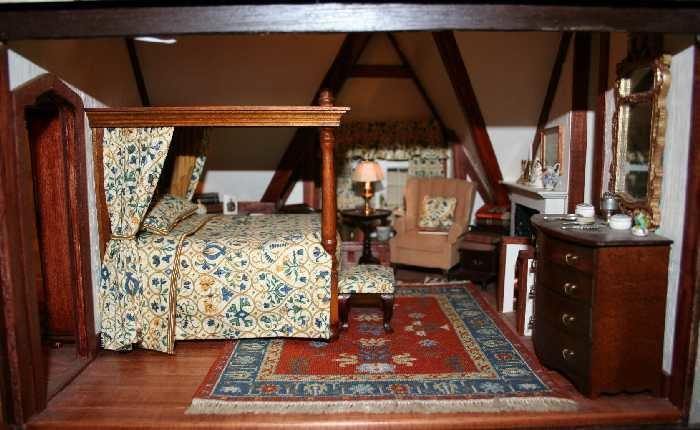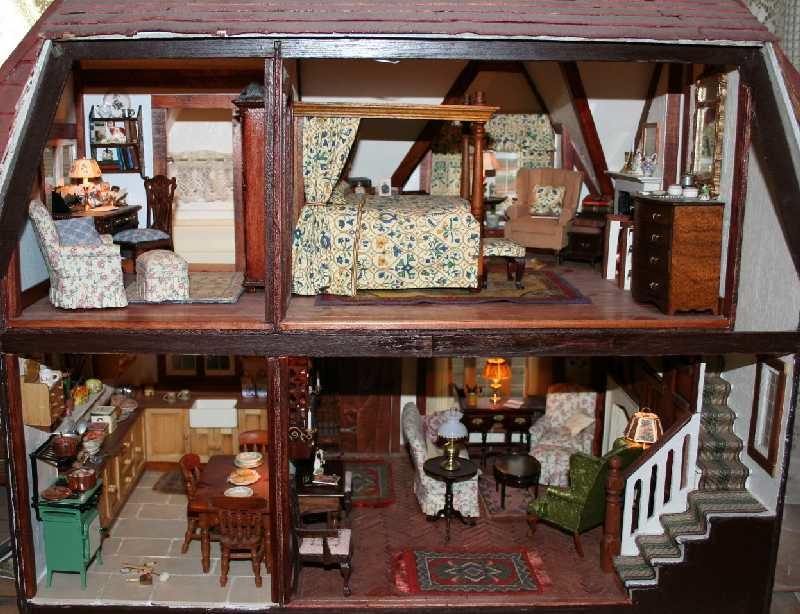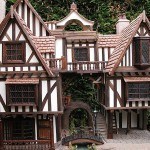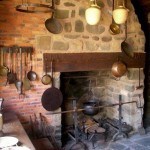The Tudor Bedchamber
The bed was the largest and most expensive piece of furniture in the Tudor home, its size and quality denoted the owner’s wealth. Everything else in the bedchamber was secondary.
The wealthy purchased four-poster beds, which were elaborately carved, with a canopy and valance of embroidered material. Heavy curtains allowed for privacy (a new concept advanced by the Tutor gentry) and kept out the cold. Edgings of fur were common to hold in warmth; “ermine for the King; squirrel for the middle classes.”
The merchant class might have four-posters, but the wood was usually plain, and the canopy had less ornamentation. The poor didn’t have beds. When it was time to got to sleep, they literally “hit the hay,” sleeping on straw pallets or rough mats covered with a sheet, if they had one.
The Manor Bedchamber
Being comfortable was not uppermost in the minds of people in Medieval times. Just staying alive was sufficient. The Tudor era changed that, and the most important piece of furniture in the home was the first to benefit from new ideas in design.
The rope bed was not new. A “charpoy of woven of rope” is mentioned in Homer’s “The Odyssey.” Adding four posts and a tent was new. Four-posters were often of elaborate design, with a headboard of carved panels, posts amply enriched with carving, a tester (canopy) and valance of embroidered material, and a coverlet of fine needlework. This transformed the bed into a separate chamber
All sorts of colors and combinations were used in the outer bedding and drapery: vibrant reds, greens, yellows and blacks being popular, along with cloth of silver and gold and many colored tassels and fringes.
Beds could also be social places. The richest worthies met guests and conducted meetings from them. Key events of birth and death had far greater public significance for royalty and the wealthy, often being witnessed by friends, family and interested parties, with privacy being far less common.
Regarding other items found in the bedchamber, read Sir Thomas Offley inventory, written in 1582:
Bedstead
mattress of wool
feather bed and bolster
plain white blanket
red blanket
coverlet of green with flowers and letters
a canopy with delicate curtains of blue and yellow dyed canvas
benches around the bed
trundle bedstead
mat
mattress of wool
a feather bed and bolster
coverlet of fine cloth
cupboard
cupboard cloth of fine striped cloth
foot part before the chimney [this might be part of the metal supports used for holding up logs in a fireplace]
high chest
curtain, 2 pieces of painted cloth and a red curtain
Servants Quarters
We often see servants garrets in Tudor dollhouses furnished with the same types of pieces their betters had downstairs, just of lower quality. This was not generally the case. The norm was for servants to sleep on the floor on straw pallets or woven mats. Clothes hung on hooks of their dormitory, not in cabinets.
It was not uncommon in large manor houses for the straw pallets to be shared. At Penshurst Place in Kent, there wasn’t enough space in the garret for all the servants. The Great Hall was used as a second dormitory, with servants sleeping on the floor at night. Considering the alternatives, the hall floor was a terrific place to be: safe and warm, even if smoky, smelly and crowded.
A Middle-Class Bedchamber
A wealthy member of the merchant class might have a four poster in his bedroom too. Less ornate perhaps, but it could now have an upgrade in the mattress: feathers would replace straw in the “tick.”
It is hard to make a distinction between the furnishings in a Manor, and those in a half-timber merchant’s home. It all depended on wealth, which meant cash-money. The Royals and the gentry could purchase “on the tick” and settle accounts with tradespeople periodically. There was no credit-line for the middle class.
Many members of this growing group were social climbers. They wanted what the Gentry had. The poor didn’t figure in this equation. They would stay in a hand-to-mouth economy for the next two centuries.
Most pieces of furniture in the early Tudor years were made by local craftsmen. So theoretically, King and Commoner could have the same stuff. It all depended on what the buyer was willing to pay. A social climbing merchant would have to decide what the most important rooms were to be furnished, which was usually the public rooms: great hall or living room, drawing and dining rooms, anywhere company was entertained. If the bed was noteworthy, it would also be on display. If not, who cares about the bedchamber or kitchens.
When planning a dollhouse, it’s fun to decide who lives in it. Do some research, create a life for the Lilliputians living in your project, then prioritize the decorating of the rooms as they would. Feel free to put any item on Sir Thomas’ inventory on your shopping list, if the imagined middle-class master of your dollhouse could afford it.
Privacy
While the Tudors may have begun the desire for privacy, the old habits of communal sleeping arrangements lingered. When the matron Abigail Willey didn’t feel like having sex with her husband, she made her two children sleep in the middle of the bed, rather than taking their usual position at the sides!
The Poor
Decorating a dollhouse in beautiful colors and intricate accessories is fun … except in the servants’ garret or the drab dwellings of the poor. If authenticity is of prime concern, this is an area where you can get into trouble. By present-day standards, ALL Tudor masters were dreadful to ALL servants. It is just a matter of degrees. If you are tempted to make the servants quarters low-end versions of the “downstairs” furnishings — beware. A chair should never be “upstairs,” they were too expensive. And if an enterprising footman liberated a broken chair from the trash, he would probably be whipped for trying to live above his station.
Until late in the Tudor era, most of the poor lived in a one-room hovel. At night the work table would be folded or dismantled and stashed against the wall, where the straw-filled sleeping sacks had been stored all day. This single room was now a bedchamber. Comfort was an unimaginable luxury. For instance, a small log would serve as a pillow until needed in the fireplace. Fiber0filled pillows were reserved for women in childbirth.
Servants
Servants at the Manor faired little better. If they had a sheet to cover them, they were lucky. They seldom had anything under them for protection against the “one thousand needle points of straw that hardened their hides.” Apparently, it was considered a good thing that the lower orders should have hardened hides.
The Tudor era — from 1457 when Henry VIII ascended the throne, until 1603 when the Stuarts gained power – provides dollhouse miniaturists with a vast diversity from which to choose a project. Do some research and have fun recreating a Tudor bedchamber in miniature.
Susan Downing, with Patrick Owens








